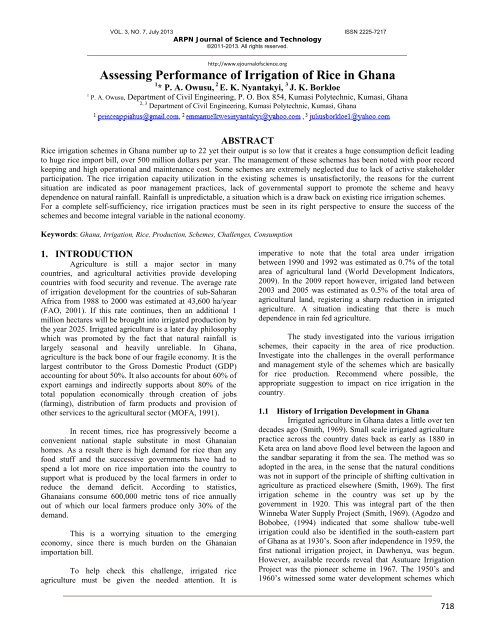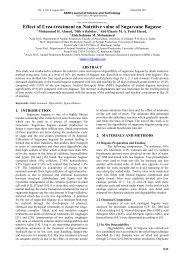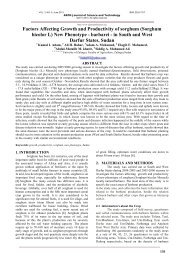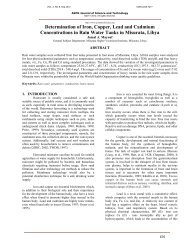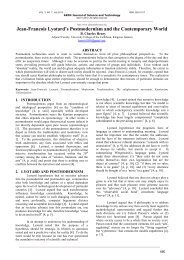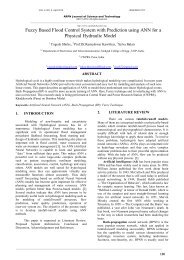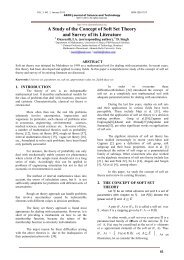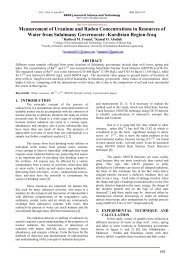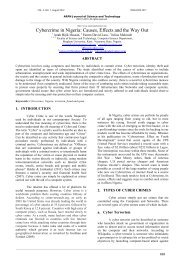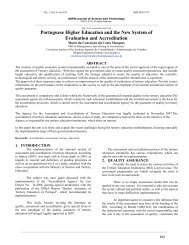Assessing Performance of Irrigation of Rice in Ghana
Assessing Performance of Irrigation of Rice in Ghana
Assessing Performance of Irrigation of Rice in Ghana
Create successful ePaper yourself
Turn your PDF publications into a flip-book with our unique Google optimized e-Paper software.
VOL. 3, NO. 7, July 2013 ISSN 2225-7217<br />
ARPN Journal <strong>of</strong> Science and Technology<br />
©2011-2013. All rights reserved.<br />
http://www.ejournal<strong>of</strong>science.org<br />
<strong>Assess<strong>in</strong>g</strong> <strong>Performance</strong> <strong>of</strong> <strong>Irrigation</strong> <strong>of</strong> <strong>Rice</strong> <strong>in</strong> <strong>Ghana</strong><br />
1 * P. A. Owusu, 2 E. K. Nyantakyi, 3 J. K. Borkloe<br />
1 P. A. Owusu, Department <strong>of</strong> Civil Eng<strong>in</strong>eer<strong>in</strong>g, P. O. Box 854, Kumasi Polytechnic, Kumasi, <strong>Ghana</strong><br />
2, 3<br />
Department <strong>of</strong> Civil Eng<strong>in</strong>eer<strong>in</strong>g, Kumasi Polytechnic, Kumasi, <strong>Ghana</strong><br />
ABSTRACT<br />
<strong>Rice</strong> irrigation schemes <strong>in</strong> <strong>Ghana</strong> number up to 22 yet their output is so low that it creates a huge consumption deficit lead<strong>in</strong>g<br />
to huge rice import bill, over 500 million dollars per year. The management <strong>of</strong> these schemes has been noted with poor record<br />
keep<strong>in</strong>g and high operational and ma<strong>in</strong>tenance cost. Some schemes are extremely neglected due to lack <strong>of</strong> active stakeholder<br />
participation. The rice irrigation capacity utilization <strong>in</strong> the exist<strong>in</strong>g schemes is unsatisfactorily, the reasons for the current<br />
situation are <strong>in</strong>dicated as poor management practices, lack <strong>of</strong> governmental support to promote the scheme and heavy<br />
dependence on natural ra<strong>in</strong>fall. Ra<strong>in</strong>fall is unpredictable, a situation which is a draw back on exist<strong>in</strong>g rice irrigation schemes.<br />
For a complete self-sufficiency, rice irrigation practices must be seen <strong>in</strong> its right perspective to ensure the success <strong>of</strong> the<br />
schemes and become <strong>in</strong>tegral variable <strong>in</strong> the national economy.<br />
Keywords: <strong>Ghana</strong>, <strong>Irrigation</strong>, <strong>Rice</strong>, Production, Schemes, Challenges, Consumption<br />
1. INTRODUCTION<br />
Agriculture is still a major sector <strong>in</strong> many<br />
countries, and agricultural activities provide develop<strong>in</strong>g<br />
countries with food security and revenue. The average rate<br />
<strong>of</strong> irrigation development for the countries <strong>of</strong> sub-Saharan<br />
Africa from 1988 to 2000 was estimated at 43,600 ha/year<br />
(FAO, 2001). If this rate cont<strong>in</strong>ues, then an additional 1<br />
million hectares will be brought <strong>in</strong>to irrigated production by<br />
the year 2025. Irrigated agriculture is a later day philosophy<br />
which was promoted by the fact that natural ra<strong>in</strong>fall is<br />
largely seasonal and heavily unreliable. In <strong>Ghana</strong>,<br />
agriculture is the back bone <strong>of</strong> our fragile economy. It is the<br />
largest contributor to the Gross Domestic Product (GDP)<br />
account<strong>in</strong>g for about 50%. It also accounts for about 60% <strong>of</strong><br />
export earn<strong>in</strong>gs and <strong>in</strong>directly supports about 80% <strong>of</strong> the<br />
total population economically through creation <strong>of</strong> jobs<br />
(farm<strong>in</strong>g), distribution <strong>of</strong> farm products and provision <strong>of</strong><br />
other services to the agricultural sector (MOFA, 1991).<br />
In recent times, rice has progressively become a<br />
convenient national staple substitute <strong>in</strong> most <strong>Ghana</strong>ian<br />
homes. As a result there is high demand for rice than any<br />
food stuff and the successive governments have had to<br />
spend a lot more on rice importation <strong>in</strong>to the country to<br />
support what is produced by the local farmers <strong>in</strong> order to<br />
reduce the demand deficit. Accord<strong>in</strong>g to statistics,<br />
<strong>Ghana</strong>ians consume 600,000 metric tons <strong>of</strong> rice annually<br />
out <strong>of</strong> which our local farmers produce only 30% <strong>of</strong> the<br />
demand.<br />
This is a worry<strong>in</strong>g situation to the emerg<strong>in</strong>g<br />
economy, s<strong>in</strong>ce there is much burden on the <strong>Ghana</strong>ian<br />
importation bill.<br />
To help check this challenge, irrigated rice<br />
agriculture must be given the needed attention. It is<br />
imperative to note that the total area under irrigation<br />
between 1990 and 1992 was estimated as 0.7% <strong>of</strong> the total<br />
area <strong>of</strong> agricultural land (World Development Indicators,<br />
2009). In the 2009 report however, irrigated land between<br />
2003 and 2005 was estimated as 0.5% <strong>of</strong> the total area <strong>of</strong><br />
agricultural land, register<strong>in</strong>g a sharp reduction <strong>in</strong> irrigated<br />
agriculture. A situation <strong>in</strong>dicat<strong>in</strong>g that there is much<br />
dependence <strong>in</strong> ra<strong>in</strong> fed agriculture.<br />
The study <strong>in</strong>vestigated <strong>in</strong>to the various irrigation<br />
schemes, their capacity <strong>in</strong> the area <strong>of</strong> rice production.<br />
Investigate <strong>in</strong>to the challenges <strong>in</strong> the overall performance<br />
and management style <strong>of</strong> the schemes which are basically<br />
for rice production. Recommend where possible, the<br />
appropriate suggestion to impact on rice irrigation <strong>in</strong> the<br />
country.<br />
1.1 History <strong>of</strong> <strong>Irrigation</strong> Development <strong>in</strong> <strong>Ghana</strong><br />
Irrigated agriculture <strong>in</strong> <strong>Ghana</strong> dates a little over ten<br />
decades ago (Smith, 1969). Small scale irrigated agriculture<br />
practice across the country dates back as early as 1880 <strong>in</strong><br />
Keta area on land above flood level between the lagoon and<br />
the sandbar separat<strong>in</strong>g it from the sea. The method was so<br />
adopted <strong>in</strong> the area, <strong>in</strong> the sense that the natural conditions<br />
was not <strong>in</strong> support <strong>of</strong> the pr<strong>in</strong>ciple <strong>of</strong> shift<strong>in</strong>g cultivation <strong>in</strong><br />
agriculture as practiced elsewhere (Smith, 1969). The first<br />
irrigation scheme <strong>in</strong> the country was set up by the<br />
government <strong>in</strong> 1920. This was <strong>in</strong>tegral part <strong>of</strong> the then<br />
W<strong>in</strong>neba Water Supply Project (Smith, 1969). (Agodzo and<br />
Bobobee, (1994) <strong>in</strong>dicated that some shallow tube-well<br />
irrigation could also be identified <strong>in</strong> the south-eastern part<br />
<strong>of</strong> <strong>Ghana</strong> as at 1930’s. Soon after <strong>in</strong>dependence <strong>in</strong> 1959, the<br />
first national irrigation project, <strong>in</strong> Dawhenya, was begun.<br />
However, available records reveal that Asutuare <strong>Irrigation</strong><br />
Project was the pioneer scheme <strong>in</strong> 1967. The 1950’s and<br />
1960’s witnessed some water development schemes which<br />
718
VOL. 3, NO. 7, July 2013 ISSN 2225-7217<br />
ARPN Journal <strong>of</strong> Science and Technology<br />
©2011-2013. All rights reserved.<br />
accounted for about 240 earth dams and dug-outs <strong>in</strong> the<br />
north and about 66 <strong>in</strong> the Ho-Keta pla<strong>in</strong>s <strong>of</strong> the south<br />
purposely to provide water for dry season irrigated<br />
agriculture. Currently irrigation schemes are managed by<br />
the <strong>Ghana</strong> <strong>Irrigation</strong> Authority (GIDA) set up by Suprem<br />
Military Council Decree (S.M.C.D) 85, 1977 and their<br />
function is to provide for the development <strong>of</strong> irrigation and<br />
other related matters.<br />
2.1 Justification <strong>of</strong> <strong>Rice</strong> <strong>Irrigation</strong> <strong>in</strong> <strong>Ghana</strong><br />
There is obviously no dispute about the fact that<br />
water is an important <strong>in</strong>put <strong>in</strong> agricultural production <strong>in</strong><br />
<strong>Ghana</strong> beside labour force. Virtually, all agricultural<br />
production <strong>in</strong> <strong>Ghana</strong> depends heavily on natural ra<strong>in</strong>fall<br />
which can be unpredictable. Accord<strong>in</strong>g to available<br />
statistics, <strong>Ghana</strong>ians consume 600,000 metric tons <strong>of</strong> rice<br />
annually out <strong>of</strong> which our local farmers produce only 30%<br />
<strong>of</strong> the demand. The rema<strong>in</strong><strong>in</strong>g two-thirds, worth over 500<br />
million dollars, are imported. The figure is alarm<strong>in</strong>g when it<br />
is juxtaposed aga<strong>in</strong>st the situation <strong>in</strong> 1999-2000 when the<br />
rice import bill was 100 million dollars. This situation is<br />
very worry<strong>in</strong>g to the emerg<strong>in</strong>g economy, s<strong>in</strong>ce it posses<br />
much burden on the <strong>Ghana</strong>ian importation bill. The gab can<br />
only be bridge by comprehensive irrigated rice agriculture<br />
where there is a complete shift from total dependence on<br />
natural ra<strong>in</strong>fall to all year round water availability. A well<br />
developed scheme will serve as a panacea to achieve; food<br />
security, poverty reduction, and rural employment.<br />
Despite irrigation’s considerable potential and the<br />
emphasis placed on it <strong>in</strong> recent plans, the proportion <strong>of</strong><br />
potential irrigable land actually under irrigation is<br />
<strong>in</strong>significant. In addition, the performance and productivity<br />
<strong>of</strong> exist<strong>in</strong>g irrigation schemes, particularly those that were<br />
publicly developed, are generally low (GIDA/JICA 2004).<br />
F<strong>in</strong>ally the agricultural lands capacity on rice production<br />
potential is exceptionally good to the extent that it can<br />
supply for the whole <strong>of</strong> the sub-region with a good return on<br />
revenue generation to support the national economy.<br />
However, this cannot be achieved for now, s<strong>in</strong>ce there is<br />
much dependence on ra<strong>in</strong> fed cultivation with poor yields.<br />
2. STUDY AREA<br />
<strong>Ghana</strong> is fairly well endowed with water resources,<br />
but there is a high variability <strong>in</strong> the amount <strong>of</strong> available<br />
water with<strong>in</strong> the year and over several years. Total land<br />
surface area is 238,000km 2 . It is located between lat. 4 0 30 ’<br />
and 11 0 N and longitude 1 0 10'E and 3 0 15'W. It shares<br />
borders with Cote d’Ivoire on the West, Republic <strong>of</strong> Togo<br />
on the East, Burk<strong>in</strong>a Faso on the north and Atlantic Ocean<br />
(Gulf <strong>of</strong> gu<strong>in</strong>ea) <strong>in</strong> the south. <strong>Ghana</strong> receives average<br />
http://www.ejournal<strong>of</strong>science.org<br />
annual precipitation <strong>of</strong> 283.2 billion m 3 . The mean annual<br />
ra<strong>in</strong>fall reaches a high <strong>of</strong> 2,240 mm <strong>in</strong> the extreme<br />
southwest. It reduces eastward and northwards to about 800<br />
mm <strong>in</strong> Accra on the southwest coastal savanna zone, and<br />
970mm <strong>in</strong> the extreme northeast. Mean annual temperature<br />
is 30 o C. Relative humidity is highest at the coast with a<br />
mean <strong>of</strong> 90% and a dry season low <strong>of</strong> 20% <strong>in</strong> the north.<br />
Potential evapo-transpiration ranges from 1,011mm <strong>in</strong> the<br />
ra<strong>in</strong> forest zone to 2,412 mm <strong>in</strong> the northern savannah zone<br />
(FAO, 2005).<br />
2.1 <strong>Irrigation</strong> Schemes <strong>in</strong> <strong>Ghana</strong><br />
There are about forty <strong>of</strong>ficial irrigation schemes<br />
across the length and breadth <strong>of</strong> the country. The <strong>Ghana</strong><br />
<strong>Irrigation</strong> Development Authority (GIDA) has 22 irrigation<br />
schemes cultivat<strong>in</strong>g rice under its Jurisdiction cover<strong>in</strong>g<br />
about 14,100 ha out <strong>of</strong> which 53% are developed and about<br />
5478 ha is actually put under irrigation (status <strong>of</strong> June<br />
2003). Table 1 <strong>in</strong>dicates the various irrigation schemes and<br />
their potential across the country.<br />
2.2 <strong>Rice</strong> <strong>Irrigation</strong> Schemes <strong>in</strong> <strong>Ghana</strong><br />
The self-sufficiency policy, adopted <strong>in</strong> <strong>Ghana</strong><br />
dur<strong>in</strong>g the 1970s, resulted <strong>in</strong> the creation <strong>of</strong> the <strong>Ghana</strong><br />
<strong>Irrigation</strong> Development Authority (GIDA) <strong>of</strong> the M<strong>in</strong>istry<br />
<strong>of</strong> Agriculture as a semi-autonomous organization <strong>in</strong> 1977.<br />
In GIDA, a lot <strong>of</strong> emphasis was placed on the development<br />
<strong>of</strong> large-scale irrigation projects for the production <strong>of</strong> rice.<br />
The ultimate aim was to reduce the country’s dependency<br />
on imported rice. At present, GIDA has more than twenty<br />
on-go<strong>in</strong>g projects, scattered throughout the country, with<br />
sizes <strong>of</strong> schemes rang<strong>in</strong>g from 10 to about 3000ha. The total<br />
area developed by GIDA for irrigation and mostly rice<br />
cultivation is at present about 10,000ha. <strong>Rice</strong> yields on the<br />
irrigation projects vary between 4.0–6.0t/ha, with an<br />
average yield <strong>of</strong> about 4.6t/ha. Yields <strong>of</strong> rice on irrigation<br />
schemes, and cropp<strong>in</strong>g <strong>in</strong>tensity, are directly related to the<br />
amount <strong>of</strong> water available from season to season. It is<br />
estimated that the contribution <strong>of</strong> irrigated agriculture to the<br />
total national rice production needs to be about 24% <strong>in</strong><br />
order to satisfy national demand. Schemes <strong>in</strong>to rice<br />
irrigation cultivation are shown <strong>in</strong> the Table 2. Only seven<br />
<strong>of</strong> the schemes are seriously <strong>in</strong>to rice irrigation. The others<br />
are shared schemes which <strong>in</strong> cooperates mix cropp<strong>in</strong>g;<br />
<strong>in</strong>volv<strong>in</strong>g rice and other crops especially vegetables.<br />
719
VOL. 3, NO. 7, July 2013 ISSN 2225-7217<br />
ARPN Journal <strong>of</strong> Science and Technology<br />
©2011-2013. All rights reserved.<br />
http://www.ejournal<strong>of</strong>science.org<br />
Table 1: <strong>Irrigation</strong> projects and their potential<br />
No. <strong>Irrigation</strong> Project<br />
<strong>Irrigation</strong><br />
Potential(Ha) No. <strong>Irrigation</strong> Project<br />
<strong>Irrigation</strong><br />
Potential(Ha)<br />
1 Accra Pla<strong>in</strong>s 178.2 21 Kpong 2024<br />
2 Adidome 200 22 Kpong Farms 1000<br />
3 Affife 1012 23 Mankessim 324<br />
4 Afram Pla<strong>in</strong>s 202 24 Medium and samall schemes 101205<br />
5 Akumandan 810 25 Nobewam 215<br />
6 Ashiaman 235 26 Okyereko 121<br />
7 Asutuare 2000 27 Pwalugu 95175<br />
8 Aveyime 8000 28 Passam 1250<br />
9 Avu-Keta (MPS) 30370 29 Sata 40<br />
10 Avu-Keta (PF) 40 30 Small schemes (ASIP) 2900<br />
11 Ayensu 3500 31 Subonpan 20<br />
12 Bontanga 540 32 Tamne 500<br />
13 Bui (MPS) 32400 33 Tanoso 1200<br />
14 Dawhenya 486 34 Tono 2632<br />
15 Demon 400 35 Valley Bottom 600<br />
16 Dodenu 20 36 Vea 1417<br />
17 Gol<strong>in</strong>ga 100 37 Volta Lakeshore 400<br />
18 Inland valleys (IVRDP) 4600 38 Weija 2267<br />
19 Kikam 27 39 Yapei 5200<br />
20 Komenda 1215 40 Zongo-Macheri 4000<br />
[Compiled from FAO 1985, Agodozo and Bobobee (1994)]<br />
Location/Scheme<br />
Table 2: <strong>Irrigation</strong> projects grow<strong>in</strong>g rice and/or other crops <strong>in</strong> <strong>Ghana</strong><br />
Potential<br />
area (ha)<br />
Developed area<br />
(ha)<br />
<strong>Irrigation</strong> system (Ggravity,<br />
P- pump<strong>in</strong>g<br />
scheme)<br />
Ashiaman 155 135 G <strong>Rice</strong><br />
Dawhenya 450 191 P+G <strong>Rice</strong><br />
Major crops<br />
cultivated<br />
Kpong 3028 1400 G <strong>Rice</strong>, Vegetables<br />
Weija 1200 220 P Vegetables<br />
Afife 880 880 G <strong>Rice</strong>, Vegetables<br />
Aveyime 280 60 P+G <strong>Rice</strong><br />
Kpando- Torkor 400 40 P Vegetables<br />
Okyereko 100 40 P+G <strong>Rice</strong><br />
Mankessim 320 17 P Vegetables<br />
Amante 300 101 P Vegetables<br />
Dedeso 880 30 P Vegetables<br />
Akumandan 150 65 P Vegetables<br />
Nobewam 150 120 P+G <strong>Rice</strong><br />
Sata 32 32 G Vegetables<br />
Sub<strong>in</strong>ja 150 60 P Vegetables<br />
Tanaso 1200 64 P Vegetables<br />
Bontanga 540 450 G <strong>Rice</strong>, Vegetables<br />
Gol<strong>in</strong>ga 130 26 G <strong>Rice</strong><br />
720
VOL. 3, NO. 7, July 2013 ISSN 2225-7217<br />
ARPN Journal <strong>of</strong> Science and Technology<br />
©2011-2013. All rights reserved.<br />
http://www.ejournal<strong>of</strong>science.org<br />
Libga 40 20 G Vegetables<br />
Kikam 35 27 P+G <strong>Rice</strong><br />
Tono 2632 2400 G <strong>Rice</strong>, Vegetables<br />
Vea 1000 1000 G <strong>Rice</strong>, Vegetables<br />
Total 14052 7378<br />
3. MATERIALS AND METHODS<br />
The methods used for this study <strong>in</strong>clude collation <strong>of</strong><br />
<strong>in</strong>formation, reports, and data from GIDA, <strong>Ghana</strong> Ports and<br />
Habour Authority, Institute <strong>of</strong> Water Management<br />
Source: GIDA 2000<br />
In recent times there have been calls by certa<strong>in</strong><br />
<strong>in</strong>terest groups on government to raise tariffs on imported<br />
rice from 20 percent to 30 percent. Accord<strong>in</strong>g to this group<br />
International, and other sources. Review <strong>of</strong> relevant <strong>of</strong> people, they believe this would help boost domestic rice<br />
literature, <strong>in</strong>clud<strong>in</strong>g a wide range <strong>of</strong> files, onl<strong>in</strong>e production and consequently reduce volume <strong>of</strong> imported<br />
publications, and published and unpublished reports on rice. <strong>Ghana</strong> experienced a rapid dietary shift to rice,<br />
relevant works on rice cultivation schemes <strong>in</strong> <strong>Ghana</strong>. particularly <strong>in</strong> the urban centres, dur<strong>in</strong>g the early post<strong>in</strong>dependence<br />
period (start<strong>in</strong>g 1957). The trend is attributed<br />
Interviews with key <strong>in</strong>formants <strong>of</strong> the various farmer groups<br />
<strong>of</strong> the irrigation schemes were also used as part <strong>of</strong> the study. to <strong>in</strong>creased <strong>in</strong>come, favorable government pric<strong>in</strong>g policies,<br />
good storability <strong>of</strong> rice and ease <strong>of</strong> cook<strong>in</strong>g (Nyanteng,<br />
4. RICE PRODUCTION IN GHANA<br />
1987). S<strong>in</strong>ce then demand has been on the <strong>in</strong>crease<br />
Accord<strong>in</strong>g to Mobil and Okran (1985), rice has<br />
progressively.<br />
been produced <strong>in</strong> <strong>Ghana</strong> for a long time. Dur<strong>in</strong>g the 17 th and<br />
18 th centuries, it was already one <strong>of</strong> the major commercial<br />
4.1 Domestic rice production<br />
food crops. Its importance was next to millet and maize and<br />
Available data show that <strong>Ghana</strong>’s rice production<br />
it was cultivated more than yam and sweet potato, the two<br />
estimates range from 200,000 to 300,000 MT <strong>of</strong> paddy rice<br />
pr<strong>in</strong>cipal root crops <strong>in</strong> the country then. Until the 1920s,<br />
or roughly 120,000 to 180,000 MT <strong>of</strong> milled rice, the bulk<br />
most <strong>of</strong> the rice <strong>in</strong> <strong>Ghana</strong> was grown <strong>in</strong> the Volta and<br />
<strong>of</strong> which comes from the Upper East, Northern and Volta<br />
Western Regions, with cultivation carried out mostly by<br />
Regions. Ra<strong>in</strong>fall rema<strong>in</strong>s the greatest driver <strong>of</strong> production<br />
females, while males focused on cash crops such as cocoa,<br />
variance. <strong>Ghana</strong>’s rice production can be categorized <strong>in</strong>to<br />
rubber and c<strong>of</strong>fee. Most <strong>of</strong> the rice varieties were grown<br />
three primary cropp<strong>in</strong>g types as <strong>in</strong>dicated by Table 3.<br />
without any improvement, as they were <strong>in</strong>herited from<br />
Lowland ra<strong>in</strong>-fed, which <strong>in</strong>cludes rice planted <strong>in</strong> the<br />
ancestors, and some <strong>of</strong> these varieties are still <strong>in</strong> cultivation.<br />
reced<strong>in</strong>g waters <strong>of</strong> the Volta and other rivers, accounts for<br />
In <strong>in</strong>land valleys, which are one <strong>of</strong> the ma<strong>in</strong> ecological<br />
78 %t <strong>of</strong> production; upland ra<strong>in</strong>-fed accounts for 6 %, and<br />
environments <strong>in</strong> the country, rice is grown <strong>in</strong> flooded fields.<br />
irrigated rice accounts for 16 % as <strong>in</strong>dicated <strong>in</strong> Table 3.<br />
<strong>Rice</strong> production expanded steadily from 1994 to 2004<br />
primarily from an expansion <strong>of</strong> land under paddy<br />
production.<br />
Table 3: Categorization <strong>of</strong> Paddy Fields <strong>in</strong> <strong>Ghana</strong><br />
Indicator Low land Ra<strong>in</strong>-fed Upland Ra<strong>in</strong>-fed Irrigated Total<br />
Planted Area (Ha) 93,750 18,750 10200 122,700<br />
Paddy (MT/Ha) 2.4 1 4.5 2.4<br />
Paddy Production(MT) 224,700 18,750 45,900 289,350<br />
% <strong>of</strong> Total Area 75 15 10 100<br />
% <strong>of</strong> Total Production 78 6 16 100<br />
Source: <strong>Ghana</strong>, MoFA and JICA (F<strong>in</strong>al Report, March, 2008).<br />
By the end <strong>of</strong> 2008, rice production <strong>in</strong> <strong>Ghana</strong> was<br />
estimated at 301,921 MT <strong>of</strong> paddy; yield<strong>in</strong>g roughly<br />
181,000 MT <strong>of</strong> milled rice, produce on 132,921 hectares,<br />
result<strong>in</strong>g <strong>in</strong> an average yield <strong>of</strong> 2.27MT/Ha <strong>of</strong> paddy for<br />
upland and lowland rice aggregated. It is generally agreed<br />
that current domestic production accounts for 30 % <strong>of</strong><br />
domestic consumption, approximately 600,000 MT <strong>of</strong><br />
milled rice (Awuni, 2006).<br />
721
VOL. 3, NO. 7, July 2013 ISSN 2225-7217<br />
ARPN Journal <strong>of</strong> Science and Technology<br />
©2011-2013. All rights reserved.<br />
4.2 Consumption Patterns<br />
Figure 1 depicts the deficits <strong>in</strong> domestic rice<br />
production, and imports over the period 1960 – 2012 as well<br />
as total domestic rice consumption over the same period. It<br />
is so clear that the national deficit is on a high ascendancy.<br />
The results show that there is much dependency on ra<strong>in</strong>fed<br />
agriculture or a lot <strong>of</strong> improvement has not been done <strong>in</strong><br />
most irrigation schemes. The rice production <strong>in</strong> the country<br />
was highly encourag<strong>in</strong>g <strong>in</strong> the early 70’s.<br />
Recent research by (Awuni, 2006) confirmed that<br />
most important food items <strong>in</strong> the diet <strong>of</strong> the urban poor are<br />
cereals. Across all cities, maize derivatives are the most<br />
common food consumed about 42.3 % followed by rice,<br />
http://www.ejournal<strong>of</strong>science.org<br />
33.7 %. While <strong>in</strong> Accra and Tamale, maize derivatives<br />
appear to be the first choice <strong>of</strong> food items, <strong>in</strong> Kumasi and<br />
Sekondi-Takoradi, rice appears to be the first choice <strong>of</strong><br />
most urban poor families. Current rice consumption<br />
estimates range around 30kg/capital per year as <strong>in</strong>dicated <strong>in</strong><br />
the Table 4 with projected demand <strong>in</strong> 2015 <strong>of</strong> as much as<br />
63kg/capita per year driven by steady ga<strong>in</strong>s <strong>in</strong> <strong>in</strong>come and<br />
population growth <strong>of</strong> 27.5 %.<br />
<strong>Rice</strong> Quantity ×1000 MT<br />
1000<br />
900<br />
800<br />
700<br />
600<br />
500<br />
400<br />
300<br />
200<br />
100<br />
0<br />
1960 1970 1980 1990 2000 2010 2020<br />
Year<br />
Domestic Production Domestic Consumption <strong>Rice</strong> Imports<br />
Fig 1: <strong>Ghana</strong> milled rice production, consumption and imports<br />
Table 4: Estimation <strong>of</strong> Per Capita <strong>Rice</strong> Consumption for Rural and Urban areas <strong>of</strong> <strong>Ghana</strong><br />
Indicator Urban Rural Whole Country<br />
Population 9,170,000 11,360,00 20,530,00<br />
Per Capita (Kg) 38 4.5 22.1<br />
Total (MT) 348,500 104,800 433,300<br />
Consumption Ratio<br />
(%) 76.9 23.1 100<br />
<strong>Rice</strong> production was encourag<strong>in</strong>g <strong>in</strong> the north<br />
western and north eastern part <strong>of</strong> the country as shown by<br />
Table 5. A reason largely attributed to self-sufficiency<br />
policy, adopted <strong>in</strong> <strong>Ghana</strong> dur<strong>in</strong>g the 1970s. However due to<br />
the neglect <strong>of</strong> governmental support <strong>of</strong> the irrigation<br />
schemes, these achievements became largely unsusta<strong>in</strong>able.<br />
722
VOL. 3, NO. 7, July 2013 ISSN 2225-7217<br />
ARPN Journal <strong>of</strong> Science and Technology<br />
©2011-2013. All rights reserved.<br />
Table 5: Paddy rice production by regions, <strong>Ghana</strong>, 1978 -<br />
1980<br />
Region<br />
Paddy<br />
Production<br />
(1000t)<br />
%<br />
National<br />
Production<br />
Northern 170 51<br />
Western 29.3 10.5<br />
Eastern 22.3 8<br />
Brong Ahafo 20.8 7.5<br />
Volta 14 5<br />
Upper 14 5<br />
Ashanti 4.2 1.5<br />
Central 4.2 1.5<br />
TOTAL 278.8 100<br />
Source: <strong>Ghana</strong> Statistical Services<br />
4.3 <strong>Performance</strong> <strong>of</strong> <strong>Rice</strong> Production Ecologies <strong>in</strong> <strong>Ghana</strong><br />
<strong>Rice</strong> is produced <strong>in</strong> all the ten regions <strong>of</strong> <strong>Ghana</strong>,<br />
cover<strong>in</strong>g all the major ecological-climatic zones, <strong>in</strong>clud<strong>in</strong>g<br />
the Interior Savannah zone, the High Ra<strong>in</strong> Forest zone, the<br />
Semi-deciduous Ra<strong>in</strong> Forest zone and the Coastal Savannah<br />
zone. With<strong>in</strong> each agro-ecological zone there are dist<strong>in</strong>ct<br />
rice ecosystems:<br />
The ra<strong>in</strong>fed ecology (i.e. drylands and lowlands)<br />
accounts for 78 % <strong>of</strong> the production area, the irrigated<br />
ecology for 16 % and the <strong>in</strong>land swamps and valley bottoms<br />
for 6 %. The ra<strong>in</strong>fed lowland/hydromorphic ecology is<br />
responsible for more than 60 percent <strong>of</strong> the rice area <strong>in</strong><br />
<strong>Ghana</strong> and over 80 percent <strong>of</strong> the rice area <strong>in</strong> the Interior<br />
Savannah zone where ra<strong>in</strong>fall is mono-modal as observed<br />
by Oteng, (1997). The ma<strong>in</strong> rationale beh<strong>in</strong>d the <strong>in</strong>land<br />
swamps and valley bottoms scheme is that, with<br />
development <strong>of</strong> good but simple water and soil management<br />
practices, higher crop productivity could be susta<strong>in</strong>ed <strong>in</strong> the<br />
valley bottoms and swamps, as observed by Otoo (1994).<br />
5. CHALLENGES IN IRRIGATION<br />
ECOLOGIES IN GHANA<br />
5.1 Ra<strong>in</strong>fed ecologies<br />
The major challenges are rodents and birds. In the<br />
Transitional, Semi-deciduous and High Ra<strong>in</strong> Forest zones it<br />
is imperative to fence the crop to protect it from the large<br />
rodents, Thryonomis sw<strong>in</strong>darianus or grass cutters,<br />
otherwise the whole crop could be destroyed overnight if<br />
attacked. The other equally important constra<strong>in</strong>ts are the<br />
low and erratic ra<strong>in</strong>fall, low <strong>in</strong>herent fertility <strong>of</strong> the soils<br />
and low level <strong>of</strong> technology used.<br />
http://www.ejournal<strong>of</strong>science.org<br />
Excessive ra<strong>in</strong>fall regimes, subject many rice fields<br />
to long periods <strong>of</strong> <strong>in</strong>undation. The uncontrolled floods tend<br />
to affect field operations such as weed control, fertilizer<br />
application, bird control and harvest<strong>in</strong>g, thus result<strong>in</strong>g <strong>in</strong><br />
poor yields. Prom<strong>in</strong>ent constra<strong>in</strong>ts encountered <strong>in</strong> the valley<br />
bottoms and swamps are a lack <strong>of</strong> suitable varieties and<br />
weed and pest problems.<br />
5.2 Irrigated Ecology<br />
The greatest constra<strong>in</strong>t to production is, however,<br />
the ever-<strong>in</strong>creas<strong>in</strong>g bird and rodent population, which<br />
seriously threaten the growth <strong>of</strong> the rice <strong>in</strong>dustry. The<br />
problem is exacerbated by the cont<strong>in</strong>uous monocropp<strong>in</strong>g <strong>of</strong><br />
rice season after season <strong>in</strong> the absence <strong>of</strong> a viable alternate<br />
crop <strong>in</strong> the rice bas<strong>in</strong>s. Meanwhile, under the National<br />
Agricultural Research Programme (NARP), efforts are<br />
be<strong>in</strong>g made to develop a susta<strong>in</strong>able rice-based cropp<strong>in</strong>g<br />
system to break the cycle <strong>of</strong> rice monocropp<strong>in</strong>g. The weed<br />
problem appears to be the next most important problem<br />
after pests.<br />
The most obnoxious weeds which climax <strong>in</strong> the<br />
irrigated rice culture are Ischaemum rugosum, Ech<strong>in</strong>ochloa<br />
colonum, Cyperus rotundus and Phyllanthus spp. The weed<br />
control problem has been worsened by the withdrawal <strong>of</strong><br />
subsidies on agricultural <strong>in</strong>puts, and farmers are resort<strong>in</strong>g<br />
<strong>in</strong>creas<strong>in</strong>gly to hand weed<strong>in</strong>g while also reduc<strong>in</strong>g their farm<br />
size. Lack <strong>of</strong> <strong>in</strong>frastructures such as comb<strong>in</strong>e harvesters,<br />
reapers, threshers is seriously affect<strong>in</strong>g rice output <strong>in</strong> this<br />
ecology.<br />
5.3 Climatic Uncerta<strong>in</strong>ty and Other Constra<strong>in</strong>ts<br />
The ra<strong>in</strong>fall pattern is erratic caus<strong>in</strong>g droughts<br />
and/or floods, and these environmental problems result <strong>in</strong><br />
poor germ<strong>in</strong>ation and harvest failure. Farmers also<br />
compla<strong>in</strong> about poor soil fertility, as a further limitation to<br />
rice production. Difficulties with land acquisition for rice<br />
farm<strong>in</strong>g were also mentioned as one <strong>of</strong> the constra<strong>in</strong>ts <strong>in</strong><br />
two communities. However, the majority <strong>of</strong> respondents<br />
mentioned lack <strong>of</strong> credit facilities and support mechanisms<br />
for successful agricultural production, as their ma<strong>in</strong><br />
problem rather than environmental conditions.<br />
5.4 Energy Crisis<br />
Most <strong>of</strong> the irrigation schemes have serious crisis<br />
with electricity. There is high level <strong>of</strong> unpaid bills as a<br />
result some <strong>of</strong> the schemes are disconnected from the<br />
national grid. There is therefore a sharp reduction <strong>in</strong> the<br />
production <strong>of</strong> the irrigated schemes; s<strong>in</strong>ce heavy duty<br />
electrical pumps are currently substituted with smaller<br />
diesel operated ones as the case <strong>of</strong> Nobewam. In some cases<br />
the scheme has become virtually manually operated.<br />
Subsequently, <strong>Ghana</strong>’s guest to be self-sufficient <strong>in</strong> rice<br />
production has become derailed.<br />
723
VOL. 3, NO. 7, July 2013 ISSN 2225-7217<br />
ARPN Journal <strong>of</strong> Science and Technology<br />
©2011-2013. All rights reserved.<br />
5.5 Ma<strong>in</strong>tenance <strong>of</strong> Structures<br />
On irrigated projects <strong>in</strong> <strong>Ghana</strong>, the farmers mostly<br />
do ma<strong>in</strong>tenance <strong>of</strong> irrigation structures themselves. The<br />
ma<strong>in</strong>tenance is done on the ma<strong>in</strong> channels, laterals and sub<br />
laterals, head ditches, bunds and dra<strong>in</strong>s. The government’s<br />
commitment towards the ma<strong>in</strong>tenance <strong>of</strong> the irrigation<br />
schemes is very low. There is therefore a complete neglect<br />
<strong>of</strong> some <strong>of</strong> the schemes lead<strong>in</strong>g to complete breakdown.<br />
5.6 Government Policy on Irrigated Agriculture<br />
It is the Government‘s <strong>in</strong>tention to hand over all<br />
the irrigation projects to Farmers’ Organizations who will<br />
be responsible for the adm<strong>in</strong>istration <strong>of</strong> the respective<br />
projects without any government subvention.<br />
http://www.ejournal<strong>of</strong>science.org<br />
market<strong>in</strong>g can benefit directly. What is needed is effective<br />
organization and <strong>in</strong>termediary actions by the government to<br />
enhance efficiency <strong>of</strong> the local rice <strong>in</strong>dustry and make it<br />
more competitive.<br />
There is the need for a systematic and planned<br />
local capacity build<strong>in</strong>g <strong>in</strong> order to improve rice cultivation<br />
<strong>in</strong> the country and this requires that the key aspects <strong>of</strong> the<br />
domestic rice sector, such as seeds and variety selection,<br />
mechanization and equipment, agronomic practices,<br />
thresh<strong>in</strong>g, dry<strong>in</strong>g, clean<strong>in</strong>g parboil<strong>in</strong>g and mill<strong>in</strong>g be<br />
thoroughly overhauled and susta<strong>in</strong>ably managed. A solid<br />
foundation must first and foremost be laid to enable the<br />
domestic rice sector to take <strong>of</strong>f without any ripple effect.<br />
Currently, the Government is suppose to provide<br />
mach<strong>in</strong>ery services for hire to the farmers and also carries<br />
out rehabilitation works on the projects but this is not forth<br />
com<strong>in</strong>g. Extension <strong>of</strong>ficers are very few and they have to<br />
shuttle between projects sites over a relatively long<br />
distances without any means <strong>of</strong> transportation. Hence the<br />
quality <strong>of</strong> their attached service to the various projects,<br />
help<strong>in</strong>g farmers to improve technology is relegated to the<br />
background.<br />
5.7 Departure <strong>of</strong> Farmers from <strong>Irrigation</strong> Schemes<br />
Higher wages <strong>in</strong> urban areas and rural poverty<br />
cause labour migration from the countryside to the urban<br />
centers. This creates labour crisis on the farmlands<br />
particularly dur<strong>in</strong>g seasons when farm work is heaviest.<br />
When labour becomes scarce and more expensive, farmers<br />
are forced to use labour sav<strong>in</strong>g technologies <strong>in</strong>clud<strong>in</strong>g<br />
herbicides and mechanisation. In the long term this may<br />
lead to an <strong>in</strong>crease <strong>in</strong> the size <strong>of</strong> rice farms.<br />
The decl<strong>in</strong><strong>in</strong>g efficiency <strong>of</strong> chemical fertilisers,<br />
pesticides and irrigation water <strong>in</strong>duced by the above<br />
mentioned ecological problems together with the <strong>in</strong>creas<strong>in</strong>g<br />
costs <strong>of</strong> labour and <strong>in</strong>puts relative to the price <strong>of</strong> paddy have<br />
contributed to mak<strong>in</strong>g rice farm<strong>in</strong>g less pr<strong>of</strong>itable.<br />
Liberalisation and the globalisation <strong>of</strong> the rice market have<br />
put further pressure on rice prices. The general decl<strong>in</strong>e <strong>in</strong><br />
the terms <strong>of</strong> trade between agricultural and <strong>in</strong>dustrial<br />
products and services has also helped to marg<strong>in</strong>alize rice<br />
farm<strong>in</strong>g economically and farmers are be<strong>in</strong>g forced to look<br />
for other sources <strong>of</strong> <strong>in</strong>come. Young people are be<strong>in</strong>g driven<br />
to seek employment outside agriculture and, <strong>in</strong> the longterm,<br />
this may mean that the number <strong>of</strong> farmers will<br />
decl<strong>in</strong>e.<br />
6. CONCLUSION<br />
Given the exist<strong>in</strong>g structure <strong>of</strong> the local rice<br />
<strong>in</strong>dustries, <strong>in</strong>creas<strong>in</strong>g the tariff rates on imported rice would<br />
not be detrimental to the importers but will rather affect the<br />
common urban poor consumer. In the long run, however, if<br />
the structures are put <strong>in</strong> place, local rice production and<br />
A number <strong>of</strong> adaptation options <strong>in</strong> agriculture face<br />
a dilemma. Increas<strong>in</strong>g water availability and <strong>in</strong>creas<strong>in</strong>g the<br />
reliability <strong>of</strong> water <strong>in</strong> agriculture, i.e. through irrigation, is<br />
one <strong>of</strong> the preferred options to <strong>in</strong>crease productivity and<br />
contribute to poverty reduction. Prospects for rice irrigation<br />
development now and the future are bright provided it will<br />
be accorded the required priority at the highest level.<br />
The issue <strong>of</strong> cost has always bedeviled the<br />
irrigation schemes. This should be conta<strong>in</strong>ed by the<br />
government through clear cut policies <strong>in</strong> order to make<br />
irrigation and its management affordable. Currently less<br />
than 4% <strong>of</strong> the total national budget is allocated to the agric<br />
sector although it is the largest provider <strong>of</strong> <strong>Ghana</strong>’s<br />
population with jobs. Aga<strong>in</strong> the database for rice irrigation<br />
must be highly improved through proper record keep<strong>in</strong>g on<br />
projects and research. Research must also aim at improv<strong>in</strong>g<br />
the yields and optimiz<strong>in</strong>g water usage on projects. Lastly<br />
local capacity to manage rice irrigation schemes should also<br />
be developed by runn<strong>in</strong>g good irrigation tra<strong>in</strong><strong>in</strong>g<br />
programmes at the tra<strong>in</strong><strong>in</strong>g <strong>in</strong>stitutions.<br />
REFERENCES<br />
[1] Adu, S.V. & Stobbs, A.R. Soil <strong>of</strong> the Nasia Bas<strong>in</strong>.<br />
Soil Research Institute, <strong>Ghana</strong> Agricultural Research<br />
Station. Unpublished resources<br />
[2] Awuni, J. (2006). <strong>Rice</strong> production <strong>in</strong> <strong>Ghana</strong>, Daily<br />
Graphic, September, 12, 2006<br />
[3] Atsu-Ahebor, U.K. (1994). Keynote address<br />
delivered at the International Sem<strong>in</strong>ar, Towards <strong>Rice</strong><br />
Self-Sufficiency <strong>in</strong> <strong>Ghana</strong>, 6-7 June 1994,<br />
Akosombo, <strong>Ghana</strong><br />
[4] FAO. (2001). Smallholder <strong>Irrigation</strong> Technology:<br />
Prospects for Sub-Saharan Africa. International<br />
Programme for Technology and Research <strong>in</strong><br />
<strong>Irrigation</strong> and Dra<strong>in</strong>age, Knowledge Synthesis<br />
Report No. 3, Rome.<br />
724
VOL. 3, NO. 7, July 2013 ISSN 2225-7217<br />
ARPN Journal <strong>of</strong> Science and Technology<br />
©2011-2013. All rights reserved.<br />
[5] FAO. (2005). Aquastat: Country data on <strong>Ghana</strong>.<br />
FAO, Rome. Cited from<br />
www.fao.org/ag/agl/aglw/aquastat/countries/ghana/<strong>in</strong><br />
dex.stm Accessed October, 2012.<br />
[6] Kranjac-Berisavljevic, G., Blench, R.M. and<br />
Chapman Gordana, R. <strong>Rice</strong> Production and<br />
Livelihoods <strong>in</strong> <strong>Ghana</strong><br />
[7] Government <strong>of</strong> <strong>Ghana</strong>, (1991). Agriculture <strong>in</strong> <strong>Ghana</strong>.<br />
Facts and figures Accra, M<strong>in</strong>istry <strong>of</strong> Food and<br />
Agriculture, PPMED.<br />
http://www.ejournal<strong>of</strong>science.org<br />
[14] Obeng, H. (1994). Soils suitable for large-scale rice<br />
cultivation <strong>in</strong> <strong>Ghana</strong>. Paper presented at the<br />
International Sem<strong>in</strong>ar, Towards <strong>Rice</strong> Self-<br />
Sufficiency <strong>in</strong> <strong>Ghana</strong>, 6-7 June 1994, Akosombo,<br />
<strong>Ghana</strong>.<br />
[15] Oteng, J.W. (1994). Research strategies for improved<br />
rice production <strong>in</strong> <strong>Ghana</strong>. Paper presented at the<br />
International Sem<strong>in</strong>ar, Towards <strong>Rice</strong> Self-<br />
Sufficiency <strong>in</strong> <strong>Ghana</strong>, 6-7 June 1994, Akosombo,<br />
<strong>Ghana</strong>.<br />
[8] Government <strong>of</strong> <strong>Ghana</strong>, (1996). Agriculture <strong>in</strong> <strong>Ghana</strong>.<br />
Facts and Figures. Accra, M<strong>in</strong>istry <strong>of</strong> Food and<br />
Agriculture, PPMED<br />
[9] <strong>Ghana</strong> <strong>Irrigation</strong> Development Authority (GIDA)<br />
and Japan International Development Agency<br />
(JICA). 2004. Strategies for effective utilization <strong>of</strong><br />
exist<strong>in</strong>g irrigation projects. Small Scale Irrigated<br />
Agriculture Promotion Project-Follow UP (SSIAPP-<br />
FU). GIDA/JICA, pp.328. Designed and pr<strong>in</strong>ted by<br />
Delaram Limited.22359, Accra, <strong>Ghana</strong>.<br />
[10] Nyanteng, V.K. (1987). <strong>Rice</strong> <strong>in</strong> West Africa.<br />
Consumption, imports and production with<br />
projections to the year 2000. Monrovia, Liberia,<br />
WARDA.<br />
[11] NARP. (1994). National Agricultural Research<br />
Strategic Plan. Draft Report. Accra.<br />
[12] N. Kyei – Baffour and E. Offori (2006). <strong>Irrigation</strong><br />
Development and Management <strong>in</strong> <strong>Ghana</strong>, prospects<br />
and Challenges, Journal <strong>of</strong> science and technologies<br />
volume 26 no. 26, August, 2006.<br />
[16] Otoo, E. (1994). Towards <strong>in</strong>creased rice production<br />
<strong>in</strong> <strong>Ghana</strong>: research on the susta<strong>in</strong>able development <strong>of</strong><br />
the <strong>in</strong>land valleys for rice production. Paper<br />
presented at the International Sem<strong>in</strong>ar, Towards <strong>Rice</strong><br />
Self-Sufficiency <strong>in</strong> <strong>Ghana</strong>, 6-7 June 1994,<br />
Akosombo, <strong>Ghana</strong>.<br />
[17] Oteng, J.W. (1997). <strong>Rice</strong> production and<br />
development <strong>in</strong> <strong>Ghana</strong> International <strong>Rice</strong><br />
Commission Newsletter Vol. 46<br />
[Available onl<strong>in</strong>e at<br />
http://www.fao.org/docrep/v6017T/v6017T00.htm]<br />
[18] Vordzorgbe, S.D. (1985). Some economic<br />
considerations <strong>in</strong> policy design for <strong>in</strong>creased rice<br />
production <strong>in</strong> <strong>Ghana</strong>. Paper presented at the National<br />
<strong>Rice</strong> Workshop, Tamale, <strong>Ghana</strong>.<br />
[19] WARDA, (1986). <strong>Rice</strong> Statistics Yearbook.<br />
Monrovia, Liberia.<br />
[20] World Development Indicators, (2009)<br />
[13] Smith, M (1996). A historical sketch <strong>of</strong> water<br />
resources development <strong>in</strong> <strong>Ghana</strong>. WRI/CSIR, Accra,<br />
<strong>Ghana</strong><br />
725


